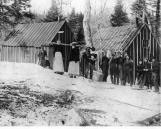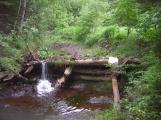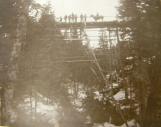1
Sawmills and GristmillsWith the abundant timber available in the area, logging has always been a big part of industry on the North Shore. With logging soon came the mills. In the early days it was practical for there to be many small mills, in order to cut down on the transportation of sawn lumber.
River John
Information about the sawmills and grist mills of River John and area are hard to find; they certainly existed for the shipbuilding industry. Reference is made to the Pictou Foundry supplying a non-condensing steam engine to a sawmill with shingle machine, smut machine and grist mill, but it burnt down in 1858.
In the 1880's George Mitchell of River John used windpower to produce two horse power, for making furniture, sashes and doors.
The 1881 census records 42 millers.
Sawmills were run by:
David Hingley 1882 -6
Malcolm McLeod 1886
Robert Graham 1892
Fletcher Bigney 1898 - 1919
William Fletcher 1905/6 -7
W.H.Langille 1906 -7
Harold Langille 1918 - 19
Owen and Bros Langille 1919
At some time there was a Silent Portable Sawmill at Cross- spruce Street sawmill
Two sawmills existed to the south of the village, toward Welsford
Gristmills also seem to have existed a short distance south of River John
Christopher Langill was listed as a miller 1871
David Langill " " 1879
George Langill " " ?
John Cavanagh " " ?
Leonard Langil (?) had a grist mill on his farm
John Ross had a grist mill from 1892 - 1908
J.W Mitchell had a grist mill and planing mill on Cross Lane and Robert Aitken had a grist mill at Weir's Bridge - dates unknown
Wallace
Captain William Reid had a saw mill on the harbour side in 1871
In 1871 there were four sawmills, and a grist mill and kiln
In 1892 Wallace had two sawmills, and two grist mills
2
William Swan Sawmill, East Wentworth/West New Annan, Nova Scotia, CanadaLate 1800's
Wentworth, Nova Scotia, Canada
 Credits:
Credits:North Shore Archives CSHC
Roy Kennedy
3
Earltown MillsHugh Munroe was a pioneer settler in 1822. He owned land at the headwaters of Nabiscump Brook and built a mill which he ran until he died in a mill accident in 1860.
James McKay had a sawmill and gristmill at McBain's Corner, powered by Nabiscump Brook. Both were destroyed by fire in 1900.
Alex McKay had a small 'up and down' mill a mile upstream of Donald McKay, on Nabiscump Brook. Working in 1871 it was probably built in response to a demand for Earltown lumber after Confederation
His heir did not continue working the mill.
Daniel McKay had a sawmill on his Nabiscump Brook property at Rossville. His was operational before 1871 and probably stopped when he died.
William McKay had a mill on Fergusons Brook, which flowed into the Waugh's River. The brook ran across his property.
John McKay had an 'up and down' water powered mill a short distance below the Earltown Falls; this provided the boards and planks for the first houses and barns for Earltown. The mill ceased when McKay died in 1869.
Donald M. Sutherland was probably operating his sawmill at the outflow of Earltown Lake in 1871. It was likely of the 'up and down' type, and appears to have been efficiently run by two men. If the mill continued to operate until 1900, it is possible a rotary saw was installed.
This was the site which John Logan took over in the early 1900's. He had a mill on Earltown Lake. On arriving at the community he was looking for industrial potential, having a knowledge of woodworking and lumber. He wanted a sawmill and a hardwood flooring shop. He planned steam power for operating the drying kiln and flooring shop, and water power to run the saw, planer,and edger. An earth and log dam at the outflow of the lake, raised the water level by 10 feet (3 metres), thus providing water for the sawmill, a holding pond in summer and an ice area for transporting logs in winter. Two fires destroyed the enterprise; the last fire in1916 completely burnt the drying kiln and the loss was not recoverable. Logan and his family returned to Truro.
4
Nabiscump Brook, McBain's Corner, Nova Scotia, Canada29 November 2010
McBain's Corner/Earltown. Nova Scotia, Canada
 Credits:
Credits:S.Brinkhurst
5
Wentworth/New AnnanThe William Swan Handle Mill operated for about 50 years, from 1850-1900, and in the height of winter employed some 100 people. There were sufficient people and buildings around the factory to give the place the name of 'Handle Town'. Most of the residential structures were tar papered, and heated by stoves.
In New Annan William and Robert Byers started a sawmill in 1827 on a west branch of the French River, and in 1832 a carding mill was added.
6
William Swan Cookhouse, East Wentworth/West New Annan, Nova Scotia, CanadaEarly 1900's
Wentworth, Nova Scotia, Canada
 Credits:
Credits:North Shore Archives CSHC
7
One of these buildings served to feed the men, with the woman on the left as cook. The other building was the bunkhouse with several men sharing a room. The tar papered buildings needed heating; both have chimneys with presumably iron stoves providing the heat and cooking fire. Occasionally, if the men could not get away from the handle mill, families would visit for a weekend, perhaps bringing extra supplies with them.8
Swan Bunkhouse, East Wentworth/ West New Annan, Nova Scotia, Canada1914
Wentworth, Nova Scotia, Canada
 Credits:
Credits:North Shore Archives CSHC
9
The sawmill that William Swan owned certainly supplied the shipyards with timber for the construction of ships, and probably provided the cargo as well. As ships built were only paid for on delivery at their destination, often some months away, William had shares in them in place of payment for what he supplied. As a result there were probably times when money was slow in coming in and therefore in short supply, making payment to sawmill workers difficult.10
McLeod Brook Dam,(1) New Annan, Nova Scotia, Canada29 June 2010
New Annan, Nova Scotia, Canada
 Credits:
Credits:Jim MacIntosh
11
In 1900, McLeod's daughter married a John Grace, after he had returned from searching for gold in the Yukon. John took up farming but repaired the old mill dam on his property, creating a pond to supply ice for cold storage.Eventually quite an industry started in the North Shore supplying blocks of ice to households, cutting the ice from various lakes in the area. The Tatamagouche Creamery that opened in the 1920's relied heavily on this source of supply, storing the ice in a special ice house, well lined with sawdust, to prevent the ice thawing.
At the head of McLeod Brook, a map of 1904 shows an 'old mill', but nothing is known about it although it might have Acadian origins.
12
Trestle Bridge, near Farm Lake, Nova Scotia, Canada1895
Between Farm Lake and Oliver, Nova Scotia, Canada
 Credits:
Credits:North Shore Archives CSHC
13
According to the note on the back of the photograph, "this log bridge was built about two miles below the outlet of Farm Lake. It was 270 feet (81m) long and 62 feet (18.6m) above the water of the river. Built for Rufus McNutt's logging in 1897-1898, it was used for five years and got rid of a detour of about seven miles."However in Ralph S. Johnson's book "Forests of Nova Scotia" (1986) there is a reference to T.G. McMullen, the 'Lumber King of Nova Scotia', who in 1892 acquired 30.000 acres (12,000 hectares) of land on Tatamagouche Mountain. He built a sawmill and sluiceway to convey lumber and then moved two portable mills to remote locations on the mountain. A bridge was required to span a narrow ravine near Farm Lake, in order to save a long log haul to one of the portable mills. He used spruce trees growing in the ravine by cutting off the tops at the required height and adding supports as necessary, so the bridge was built economically and in fact lasted a number of years.
It is unlikely that there were two such structures near Farm Lake, but neither reference mentions both McNutt and McMullen.
In 1857, Abraham Patterson went into partnership with James Primrose; the Howard Mills were near Farm Lake, New Annan. The mill was said to have a gang saw, enabling several planks to be sawn at one time, and sawgates came from the Pictou Foundry. They sent lumber to be shipped through Tatamagouche to Pictou (Nova Scotia), Sydney (Cape Breton), Truro, and Sherbrook (Nova Scotia). The trestle bridge was possibly part of all this, with Rufus McNutt coming on to the scene at the later date.
14
Sutherland Steam Mill Today, Denmark, Nova Scotia, Canada2010
Denmark, Nova Scotia, Canada
 Credits:
Credits:S. Brinkhurst